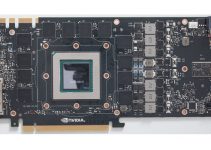The right positioning of the AIO Radiator and its Fans in a PC Case is very important because it can directly affect the airflow and cooling inside the PC Case quite significantly. It is because, unlike CPU Air Coolers, there is no single way to install an AIO Radiator and Radiator fans as you can do it in multiple ways depending on your requirements and case compatibility to achieve proper airflow inside your PC Case. Moreover, the positioning of the AIO Radiator and its fans is also affected by the PC Case you have because not all PC Cases support AIOs of all sizes and at different locations (front, top, bottom, and rear). For example, a PC Case X can only support up to 280mm AIOs while a PC Case Y can support up to 360mm AIOs. Here also, PC Case X can support 280mm AIO at the front only and not on top while PC Case Y can support 360mm AIO at the top only while can support 280mm AIO at the front and top both.
AIO PC Case Compatibility / Support for AIO
Before installing an AIO CPU Cooler, you need to know what AIO Radiator sizes (120mm/240mm/280mm/360mm) your PC Case supports and at what positions i.e. on the front, top, rear, and side or on the bottom. The most common installation point for AIO is on the front or at the top. You can find AIO Radiator compatibility information for your PC Case on the PC Case specifications page on the manufacturer’s website. So, before buying an AIO, you must know if your PC Case supports it or not and at what position. For example, if you have bought a 280mm AIO and your PC Case only supports up to 240mm Radiator or if the Case does not support that Radiator size in the position that you were desiring then it will be a sign of worry and you either have to buy a new AIO or new Computer Case for your specific requirements.
Check out: Best PC Cases for Water Cooling
AIO Cooler Radiator and Fans Positioning
Below are the various configurations for AIO Cooler Radiator and Radiator Fans installation in a PC Case.
AIO Radiator Positioning
The most common positions for mounting the AIO Radiator for most of the Micro-ATX and ATX Cases are at the Top and Front. However, some PC Cases may provide an option to mount the Radiator at the bottom. Most of the time, the Rear mounting position is only reserved for mounting a 120mm Radiator, and the Side mounting of the Radiator is only supported by a handful of PC Cases.
AIO Radiator Fans Airflow Configuration (Intake vs Exhaust)
The airflow for a radiator in a PC Case can be intake and exhaust depending on the position you are mounting it. These two airflow configurations are intake and exhaust.
Intake – In intake mode, the radiator fans will push the air through the radiator fins into the PC Case from the surroundings. This configuration will likely create positive pressure inside the PC Case.
Exhaust – In exhaust mode, the radiator fans will pull away the air through the radiator fins from the PC Case to the surroundings. This configuration will likely create negative pressure inside the PC Case.
Radiator Fans Configuration (Push or Pull, Push-Pull)
There are two ways to mount fans on the radiator based on the direction of the airflow.
Push Fan configuration – In push configuration, the fan airflow is directed over the radiator. Here, the fan pushes the cool air directly into the radiator fins and cools them down. You may also say that the fan is installed in intake mode for the radiator.
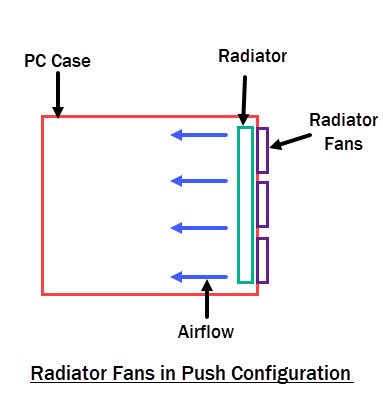
Pull Fan configuration – In pull configuration, the airflow is directed away from the radiator. Here, the fan pulls out air from the vents of the radiator and thus works as an exhaust for the radiator.
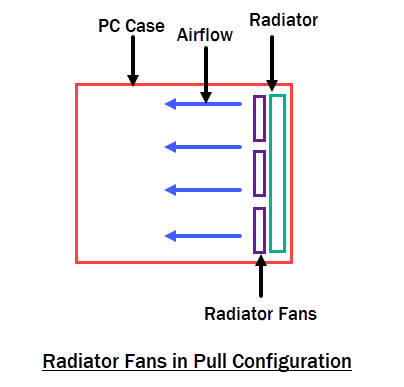
Push-Pull Fan configuration – This is a combination of Push and Pull configuration where there are two sets of fans installed at each side of the radiator, one in a push configuration and the other in a pull configuration. You may experience a slightly better reduction in AIO liquid temperature using this configuration. Not many people use this type of setup because it occupies more space in the PC Case and sometimes the cooing benefit is almost negligible.
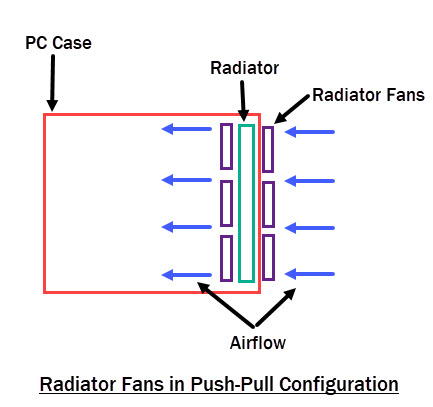
Ideal AIO Radiator Mounting Setups and Fan Configurations
Below are all the ideal mounting setups or configurations that you can use to install an AIO Liquid CPU Cooler in your PC Case.
Front Intake (Fans in Push Configuration)
In this setup, the radiator is mounted on the front panel of the PC Case and the fans are installed over the radiator in a push configuration with airflow directed into the PC Case. Here the fans are installed outside the PC Case just before the front panel cover. It is quite a popular AIO Radiator mounting configuration and delivers very good cooling performance if the front panel cover has a mesh design/big vents otherwise fan airflow would get restricted and also the cooling performance is reduced if the front panel cover is fully solid and has only side intake vents.
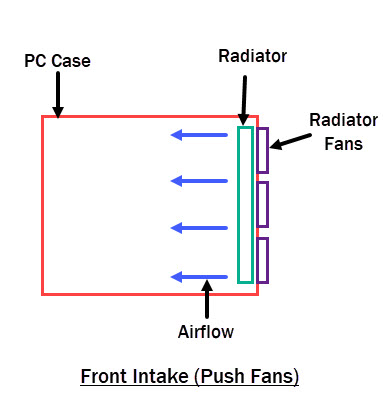
Front Intake (Fans in Pull Configuration)
This AIO radiator setup is almost similar to the above-mentioned setup except the fans are mounted in pull configuration on the radiator and they sit inside the PC Case. This setup is very useful in cases where the front panel cover does not come with mesh or front vents and only has side vents. In this setup, the radiator fans get a greater headroom for sucking air through the vents from the environment and the airflow does not get too restricted when the PC Case front panel has a solid front face.
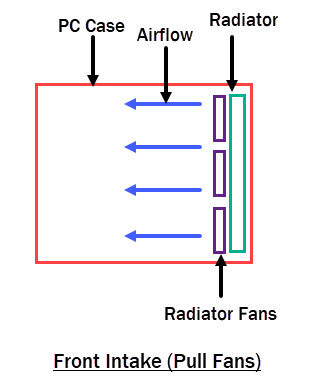
Front Intake (Fans in Push-Push Configuration)
It is the combination of Front Intake Push and Pull configuration, where there are two sets of fans, are used on the radiator, one in a push configuration and one in a pull configuration.

Top Exhaust (Fans in Push Configuration)
One of the most popular AIO Radiator configurations. Here, the radiator is mounted at the top of the PC Case with fans in push configuration. This setup works as an exhaust for the PC Case and the radiator fans pull away the hot air inside the PC Case to the environment. Here the radiator fans blow hot air from the PC Case to the radiator resulting in a higher CPU temperature compared to the Front Intake Radiator setup. However, you will get lower PC Case temperature and GPU temperature compared to the Front Intake Push or Pull radiator configuration.
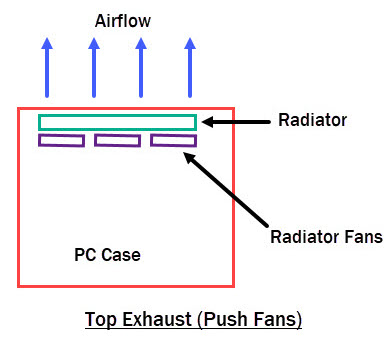
Bottom Intake (Fans in Pull Configuration)
Here, the radiator is mounted at the bottom of the PC Case with fans in pull configuration with intake airflow. This setup is quite rare and is only used when you have multiple radiators to install in the PC Case, preferably 360mm. Moreover, not many PC Cases support the bottom mounting of the radiator because the bottom space is already reserved for PSU mounting and storage drive installation in most PC Cases.
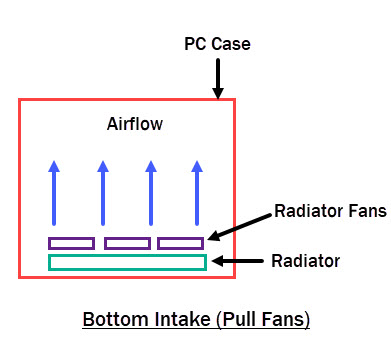
Rear Exhaust (Fans in Push Configuration)
This setup is mostly meant for 120mm AIO because most ATX and micro-ATX PC Cases have only one 120mm mounting point at the rear for exhaust fans. Here, the fan on the radiator is mounted in push configuration and it moves the air out of the PC Case through the radiator fins and works as an exhaust for the PC Case.
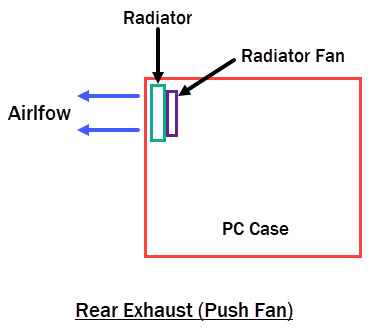
Side Exhaust (Fans in Push Configuration)
The side mounting radiator point is supported by a handful of PC Cases and also this setup is not very popular. Here, the radiator vertically sits inside the PC Case and the fans are arranged on the radiator to push air through the fins. This configuration removes hot air generated inside the PC Case through the side vents at the top and bottom.
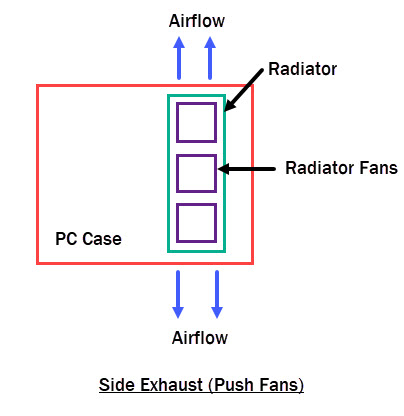
What AIO Radiator position and fan configuration should you choose?
Well, the answer to this question is not straightforward and largely depends on the PC Case you have. In most cases, the best two positions to mount the AIO are at the front and top. If your PC Case supports mounting your AIO at both the top and front then there are two factors that you have to consider.
- If you want your CPU to be on the cooler side then it is better to mount the AIO radiator in the front with fans in either push or pull configuration depending on the PC Case airflow.
- If you want your GPU to be on the cooler side, mount the radiator at the top.
The bottom mounting and side mounting radiator positions are generally used for installing multiple radiators for custom water cooling setups and should be avoided if you only have a single radiator.
| Airflow Direction in PC Case | Radiator Fans Configuration or Placement | Recommendation / Best Usage | |
| Front | Intake | Push | For PC Cases with Mesh Front Panel Cover |
| Front | Intake | Pull | For PC Cases with Solid Front Panel Cover |
| Top | Exhaust | Push | For Lower PC Case Temperature |
| Bottom | Intake | Pull | For multiple Radiator installations |
| Side | Exhaust | Push | For multiple Radiator installations |
| Rear | Exhaust | Push | For installing 120mm AIO |
What AIO Radiator Setup you should avoid?
- Front Exhaust
- Top Intake
- Bottom Exhaust
- Rear Intake
The above-mentioned radiator fan configurations or setups should be avoided because they work against or opposite to the natural airflow of the PC Case and can create turbulence of negative airflow inside the PC Case and can lead to a higher temperature of the PC Case, Graphics Card, motherboard Chipset+VRM, etc.
AIO Radiator Airflow effect on PC Temperature
When the airflow of the radiator fans is intake to the PC Case then it will result in lower CPU temperature and higher GPU and PC Case temperature. It is because, in the intake configuration, the colder air from the environment cools the radiator for the CPU. The air contacting with hot radiator fins becomes hot and enters the PC Case and raises the PC Case and GPU temperature.
In an exhaust airflow radiator setup, the radiator fans pull away the hot air from the PC Case to the surroundings or environment. This lowers the PC Case and GPU temperature compared to the Intake configuration. Here, the AIO radiator is cooled by the hot air of the PC Case and thus CPU temperature remains higher than the Intake fan configuration.
| Radiator Fan Airflow and Position | CPU Temperature | GPU Temperature | PC Case Temperature |
| Intake (Front, Bottom) | Lower | Higher | Higher |
| Exhaust (Top, Side, Rear) | Higher | Lower | Lower |
See also:
Queries?
If you still have any doubts regarding the AIO Radiator position or its fans placement then you can ask me your queries in the comment box below by clearly stating all the relevant details like PC Case, AIO Liquid Cooler, Processor, and Graphics Card model.
(*This post may contain affiliate links, which means I may receive a small commission if you choose to purchase through the links I provide (at no extra cost to you). Thank you for supporting the work I put into this site!)
![Can you Upgrade Laptop Graphics Card? [Options Available] Can you Upgrade Laptop Graphics Card? [Options Available]](https://graphicscardhub.com/wp-content/uploads/2022/04/upgrade-laptop-graphics-card-211x150.jpg)
![Graphics Cards Slot Width Explained [Single, Dual, 2.2, 2.3, 2.5, 2.75] Graphics Cards Slot Width Explained [Single, Dual, 2.2, 2.3, 2.5, 2.75]](https://graphicscardhub.com/wp-content/uploads/2019/09/graphics-card-slot-width-size-211x150.jpg)
